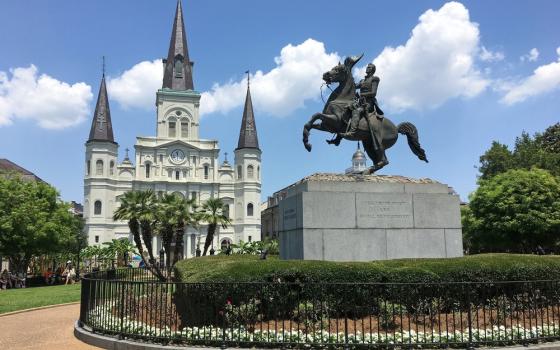
Earth and Spirit
The musical “Nunsense” and the comedy “Late Nite Catechism” hit local theaters regularly, poking raucous fun at the experience of growing up Catholic. Dressed in wimples and big rosaries, young thespians lampoon the indulgences, pious devotions and simplistic moral theology of our youth.
Confessing that I’ve made jests myself at the expense of that pre-Vatican II world, I wish to praise a Catholic upbringing and wholeheartedly thank those women religious who played a key role. Sr. Agatha Irene and her ilk may have, with help from the Baltimore Catechism and its hyperactive theological dualism, seeded hang-ups and an aberrant sense of guilt. But her kind also provided rich nourishment for a way of living, a spirituality that I have come to see as the pearl of great price.
“The religious attitude,” says artist Frederick Franck, “is rooted in wonder at the mystery of sheer being, in the axiomatic certainty that there is a meaning in our being here, in radical openness to that meaning.”
My own religious sense did not arise the first time I heard of the Immaculate Conception or the Real Presence. It awakened in first grade when my favorite cat perished under speeding wheels. Why did Pawpaw have to die? Where is she now?
Nestled in the manger of my astonishment, it incubated as I looked around me and asked: Where was I before I was born? Why does the star-filled night sky thrill me so? Why does the mystery of summer cicadas and sweet-sad bird song make me ache sometimes with nameless longings? Why must Alva Bunting up the street, such a good woman, suffer so cruelly from arthritis? Why does a mere glimpse of her granddaughter, Rita, with her raven hair and heavy-lidded brown eyes, set my heart pounding like a jackhammer?
Our Lady of Lourdes church and school offered a beginning at answering these questions, and not just by providing creeds to memorize and homilies to drowse by. My women teachers bricked in the foundations for a spirituality, the ground floor of an ongoing encounter with a tradition of wisdom, complete with techniques for prayer and strategies for inner work and conversion. Around experiences and questioning, they mounted a scaffolding of faith in things unseen yet hoped for. The sisters provided a container -- not a perfect one, but workable -- into which we could pour our striving to make sense of life and the world around us.
My Catholic education offered pious devotions but also, at its best, greenhoused a seedling sense of the world’s sacredness into flourishing growth. The Sisters of St. Joseph challenged me with concepts like social justice, with good stories and poetry. They pushed wider the circumference of my world. They dragged us to hear “Peter and the Wolf” and “The Magic Flute.” On recollection days we were required to sit tight and quietly sift our short lives through the sieve of contemplation.
This education honored the interior life. The sisters, in many various and vibrant ways, taught us that things had an inside as well as an outside, that we each had souls as full of pep as our bodies, that the best, truest adventures are the inner ones. They taught us that all manner of fears could be tamed, limitations overcome, bogeymen sent packing through our own inner donkey work.
For us boys, these women even held up models of males who had deep feelings, tenderness, creativity brooding inside them -- someone besides John Wayne or Clint Eastwood to emulate. We learned about men like Thomas Merton, Dr. Tom Dooley, Fr. Damien in the leper colony, or Van Cliburn.
They told us the story of Anne Frank hiding away in an Amsterdam attic from the cruelest organized and jackbooted hatred. Her story froze my blood even more than the fallout shelter signs hanging on the bricks outside. How would my faith and integrity hold up, I wondered, in such a terrible proving ground? Where in my own developing inner architecture could the frail egg of courage find a warm place to hatch?
The sisters provided growth in the inner life, too, by means of their own limitations. Nights after homework was done I would glue my ear to the radio. Somehow I sensed this new music from the likes of Chuck Berry, Buddy Holly, Smokey Robinson and others would prove more potent to change the world than all the Cold War’s armies put together. Sr. Pancratia wasn’t having any of it, warning us about the brain-rotting potential, but I knew she was wrong there, and thereby learned to assay, validate and honor my own best intuitions and experiences.
Authentic spirituality is necessarily intimately related to our firsthand experiences of life. It matures in prayer, reading scripture, in radical openness to what happens in the workplace, the bedroom, the newspaper, the soup kitchen downtown. That’s nunsense.
Rich Heffern is an NCR staff writer. His e-mail address is rheffern@ncronline.org.






